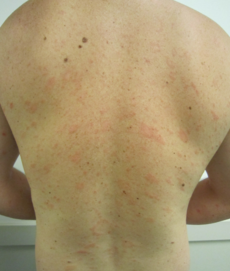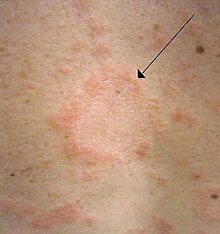Pityriasis rosea
From Wikipedia, the free encyclopedia
(Redirected from Pityriasis Rosea)
| Pityriasis rosea | |
|---|---|
| Classification and external resources | |

Pityriasis rosea on human back
| |
| ICD-10 | L42 |
| ICD-9 | 696.3 |
| DiseasesDB | 24698 |
| MedlinePlus | 000871 |
| eMedicine | derm/335 emerg/426ped/1815 |
| MeSH | D017515 |
Pityriasis rosea (also known as pityriasis rosea Gibert[1]) is a skin rash. It is benign but may inflict substantial discomfort in certain cases.[2] Classically, it begins with a single "herald patch" lesion, followed in 1 or 2 weeks by a generalized body rash lasting up to 12 weeks, however usually around 6 - 8.[3][4][5]
Contents
[hide]Signs and symptoms[edit]
The symptoms of this condition include:
- An upper respiratory tract infection may precede all other symptoms in as many as 69% of patients.[6]
- A single, 2- to (rarely) 10-cm oval red "herald" patch appears, classically on the abdomen.[5][7] Occasionally, the "herald" patch may occur in a 'hidden' position (in the armpit, for example) and not be noticed immediately. The "herald" patch may also appear as a cluster of smaller oval spots, and be mistaken for acne. Rarely, it does not become present at all.[7]
- 7–14 days after the herald patch, many small (5-10 mm) patches of pink or red, flaky, oval-shaped rash appear on the torso.[7] In 6% of cases an inverse distribution may occur, with rash mostly on the extremities.[8] The more numerous oval patches generally spread widely across the chest first, following the rib-line in a characteristic "christmas-tree" distribution.[7] Small, circular patches may appear on the back and neck several days later. It is unusual for lesions to form on the face, but they may appear on the cheeks or at the hairline.
- About one in four people with PR suffer from mild to severe symptomatic itching. (Moderate itching due to skin over-dryness is much more common, especially if soap is used to cleanse the affected areas.) The itching is often non-specific, and worsens if scratched. This tends to fade as the rash develops and does not usually last through the entire course of the disease.[7]
- The rash may be accompanied by low-grade fever, headache, nausea andfatigue. Over-the-counter medications can help manage these.[7]
Causes[edit]
The cause of pityriasis rosea is not certain, but its clinical presentation and immunologic reactions suggest a viral infectionas a cause.[9][10] Associated with HHV-7 (Human herpesvirus 7).
Diagnosis[edit]
Experienced practitioners may make the diagnosis clinically.[5] If the diagnosis is in doubt, tests may be performed to rule out similar conditions such as Lyme disease, ringworm, guttate psoriasis, nummular or discoid eczema, drug eruptions, other viral exanthems,[5] and especially secondary syphilis.[11] Abiopsy of the lesions will show extravasated erythrocytes within dermal papillae and dyskeratotic cells within the dermis.[5]
A patient is diagnosed as having pityriasis rosea if:
1. On at least one occasion or clinical encounter, he / she has all the essential clinical features and at least one of the optional clinical features, and 2. On all occasions or clinical encounters related to the rash, he / she does not have any of the exclusional clinical features.
The essential clinical features are: 1. Discrete circular or oval lesions, 2. Scaling on most lesions, and 3. Peripheral collarette scaling with central clearance on at least two lesions.
The optional clinical features are: 1. Truncal and proximal limb distribution, with less than 10% of lesions distal to mid-upper-arm and mid-thigh, 2. Orientation of most lesions along skin cleavage lines, and 3. A herald patch (not necessarily the largest) appearing at least two days before eruption of other lesions, from history of the patient or from clinical observation.
The exclusional clinical features are:
1. Multiple small vesicles at the centre of two or more lesions, 2. Two or more lesions on palmar or plantar skin surfaces, and 3. Clinical or serological evidence of secondary syphilis.
Treatment[edit]
No treatment is usually required.
Oral antihistamines or topical steroids may be used to decrease itching.[5] Steroids do provide relief from itching, and improve the appearance of the rash, but they also cause the new skin that forms (after the rash subsides) to take longer to match the surrounding skin color. While no scarring has been found to be associated with the rash, itching and scratching should be avoided. It's possible that scratching can make itching worse and an itch-scratch cycle may develop with regular scratching (that is, you itch more because you scratch, so you scratch more because you itch, and so on). Irritants such as soaps with fragrances, hot water, wool, and synthetic fabrics should be avoided; a soap containing moisturizers (such as goat's milk) may be used, however, and any generic moisturizer can help to manage over-dryness. Calamine lotion may be soothing to the skin and reduce itching. Emulsifiers should be used instead of soaps, as emulsifiers are gentler on the skin and include cleansers, eliminating the need for soap.
Direct sunlight makes the lesions resolve more quickly.[5] According to this principle, medical treatment with ultraviolet light has been used to hasten resolution,[14] though studies disagree whether it decreases itching[14] or not.[15] UV therapy is most beneficial in the first week of the eruption.[14]

